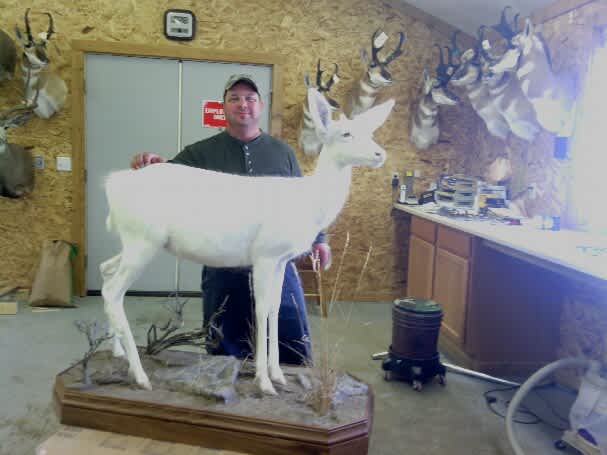One of a Kind? Jeff Foster’s 2011 Albino Mule Deer Buck
Daniel Xu 10.28.14

Just how rare are albino mule deer? Not even biologists have a definitive answer, yet some speculate that only one in 500,000 mule deer are born albino. Albinism occurs in mule deer far less frequently than in whitetail, and few ever survive into adulthood. That is why when Jeff Foster harvested a young albino mule deer buck, he suspected that it could be the only one of its kind.
“In 2010 me and a couple friends of mine were in Kaycee, Wyoming and I spotted this albino mule deer,” Foster told me. “I saw it three times and on the third time I showed it to my friends on the spotting scope and I was like, ‘Look at that!'”
Foster is an avid hunter from Swansea, Illinois, and while he travels all over the country in pursuit of game, what he saw four years ago in Wyoming stayed with him—a young buck as white as salt in the woods of Kaycee. One year later Foster returned to the same spot in the hopes of finding it again. Much to his surprise, the bowhunter found it only a half hour from where he parked on state ground.
“I was extremely lucky and I got it on my first night out hunting,” he said. “I practically ran into it.”
The buck now had two spikes on it and was feeding just about 60 yards from him.
“I was basically a nervous wreck,” Foster said, adding that he had to fight to keep his aim steady. “I knew that if I missed, I was never going to have another chance at something like it again.”

But soon Foster had the deer safely with his taxidermist. That was when he decided to do a little research on albino mule deer. It seemed that all sightings of albinism in mule deer were does, and very little information ever came up on albino bucks. In fact, Foster said that after reaching out to biologists and game wardens, none had ever heard of one being harvested by a hunter. I did some research of my own and found little to show for it as well. Around the same time that Foster bagged his buck, a photographer in Billings, Montana took a picture of an albino mule deer doe.
“I’ve hunted all my life and have never seen anything else like that,” the photographer, Nels Houghton, told the Billings Gazette. “I was pretty excited about it.”
Former Montana biologist Jay Newell said that he had only seen three albino mule deer during his time on the job, although he never specified whether any of them were male. Another biologist, Bill Wisherd of Alberta Fish and Wildlife, said he never even heard of an albino mule deer buck. Yet a few years ago, Wisherd heard the story of an old mounted mule deer doe in Edmonton. This creature was owned by Greg Szewaga, who told Canada.com that he himself bought it from the farmer who originally shot the deer back in the 1970s. Szewaga never disclosed how much he paid for the doe, but said that he intends to sell it.
“I’ll make a million with it,” Szewaga said in 2006.
Foster, however, just wants his deer somewhere that people can appreciate it.
“I would love to find a home for this deer, I want to do something cool with it. I don’t consider myself a trophy hunter, but I want to get this deer someplace where people can see it,” Foster said. “The game warden called me [not long after the hunt] and actually came in to authenticate the animal along with the taxidermist. We have an affidavit and everything set up.”
While Foster is understandably proud of the deer, he said that he also expect some criticism. Hunters as a whole have mixed opinions about harvesting white or albino animals, and the decision is usually left up to the individual hunter. Some states have laws that ban sportsmen from shooting these rare animals, but other states have since lifted them. Many wildlife biologists now consider albinism bad for deer herds, as animals born with the condition generally suffer from health issues and rarely survive into adulthood. Their white color also makes them a big target for predators.
“Albinism is a regressive trait and you don’t actually want albinos in the herd because it passes on bad traits,” Foster said. “Their hearing is less, their eyesight is less, their immune system is less. Even though they are rare, they’re actually bad for the herd.”
That being said, they are still strange and eerily beautiful creatures. Foster is continuing to do research on whether his buck is the only one of its kind, but he said that he is pleased with his deer either way. I have also reached out to several biologists and experts to see what they know about the subject.
What do you think? Have you ever seen an albino mule deer buck like this one?

